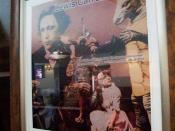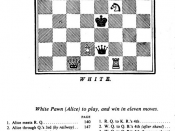An Analysis of "Jabberwocky"
"Jabberwocky" by Lewis Carroll is a nonsense poem with a good amount of fantasy imagery. The overall theme of the poem is heroism. It is supported by the repetition of nonsense words and the use of sound devices in the poem. Carroll takes the reader along on this boy's quest to kill a beast, called the Jabberwocky, and when the boy returns back home to be honored. Throughout the poem, Carroll uses a lot of cacophony to build up suspense for the reader. Thus when the boy killed the Jabberwocky, he seemed excessively heroic. For instance, some of the cacophony used are "slithy, gyre, gimble, frumious, uffish, and outgrabe." Although all of the cacophonies that were used by Carroll are not authentic words, it is unpleasant to read and hear. These words that Carroll created were not meant to have a specific meaning but rather to stir emotions and imagery in the reader.
For example, the line, "Did gyre and gimble in the wabe," does not give an accurate description of the plot. Carroll leaves the work to the reader's imagination.
The nonsense words that Carroll used are key aspects in illustrating meaning within the whole poem. The words give the poem a sense of absurdity. Carroll made up and selected these certain words so he could present the story in an exciting and fascinating way. The reader does not have to completely understand the nonsense words to understand the story because the structure of the poem is easily understood by the sound devices. The cacophony creates a nasty but thrilling setting, which gives the poem a fantasy-like essence. Carroll takes the reader through a creative journey. The nonsense words are also imaginative terms. The reader must use their own creative minds to guide...


